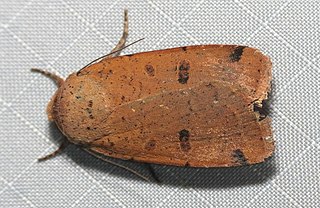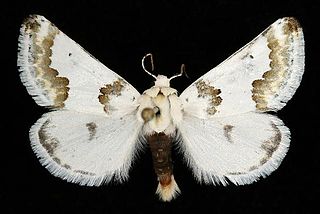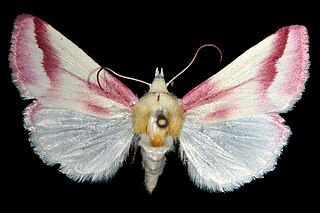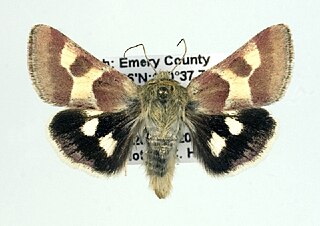
Schinia, commonly called flower moths, is a large genus of moths belonging to the family Noctuidae. The genus has a Holarctic distribution with the vast majority of species being found in North America, many with a very restricted range and larval food plant.

Pseudothyatira is a monotypic moth genus of the family Drepanidae first described by Augustus Radcliffe Grote in 1864. Its only species, Pseudothyatira cymatophoroides, the tufted thyatirid moth, was first described by Achille Guenée in 1852. It is found in North America in Newfoundland, British Columbia, northern California, Maryland, West Virginia, Kansas and North Carolina.

Abagrotis alternata, the greater red dart or mottled gray cutworm, is a moth of the family Noctuidae. The species was first described by Augustus Radcliffe Grote in 1865. It is found in eastern North America, from New Brunswick west across southern Canada to western Alberta, south to Arizona, New Mexico and the Gulf of Mexico.

Abagrotis cupida, the Cupid dart or brown climbing cutworm, is a moth of the family Noctuidae. The species was first described by Augustus Radcliffe Grote in 1865. It is found in southern Canada and in the United States east of the Rocky Mountains.
Abagrotis vittifrons is a moth of the family Noctuidae first described by Augustus Radcliffe Grote in 1864. It is found in North America from eastern North Dakota and south-western Saskatchewan west to the southern interior of British Columbia, south to southern California, Arizona and New Mexico.
Alypia ridingsii, the mountain forester or Ridings' forester, is a moth of the family Noctuidae. The species was first described by Augustus Radcliffe Grote in 1864. It is found in North America as far east as the eastern edge of the Rocky Mountains in Colorado. It is also found in Arizona, Utah, all of California and northward into Oregon, Idaho, Washington, British Columbia and Alaska

Globia oblonga, the oblong sedge borer, is a moth of the family Noctuidae. The species was first described by Augustus Radcliffe Grote in 1882. It is found across southern Canada from the Maritimes to British Columbia, south to the Gulf of Mexico and southern California.

Schinia jaguarina, the jaguar flower moth, is a moth of the family Noctuidae. The species was first described by Achille Guenée in 1852. It is found on North America's Great Plains from Saskatchewan and Alberta south to Texas, eastward on coast to Florida and westward in south to Arizona. In Mexico it is found down to Mexico City.

Schinia cumatilis, the silver-banded gem, is a moth of the family Noctuidae. The species was first described by Augustus Radcliffe Grote in 1865. It is found from the Southwestern United States into Southern Canada.

Schinia honesta, or the black-spotted gem, is a moth of the family Noctuidae. The species was first described by Augustus Radcliffe Grote in 1881. It is found in southern Canada and California. The wingspan is about 25–26 mm.

Schinia acutilinea, the angled gem or acute-lined flower moth, is a moth of the family Noctuidae. The species was first described by Augustus Radcliffe Grote in 1878. It is found in the dry southern portions of Saskatchewan, Alberta and British Columbia, south across the plains and Great Basin to southern Arizona and California.

Schinia meadi, or Mead's flower moth, is a moth of the family Noctuidae. The species was first described by Augustus Radcliffe Grote in 1873. It is found in western North America from south central Saskatchewan and central Alberta west to south central Washington, south to Arizona and New Mexico.

Schinia gaurae, the clouded crimson, is a moth of the family Noctuidae. The species was first described by James Edward Smith in 1797. It is found in North America from Illinois west across southern Saskatchewan and Alberta, south to Florida, Texas, Arizona and south into Mexico.

Schinia nuchalis, the spotted sage moth, is a moth of the family Noctuidae. The species was first described by Augustus Radcliffe Grote in 1878. It is found from the Great Plains and Great Basin, from southern Saskatchewan, Alberta and British Columbia south to northern Arizona. The Eurasian Schinia scutosa is no longer considered a synonym of Schinia nuchalis.
Schinia persimilis, the persimilis flower moth, is a moth of the family Noctuidae. The species was first described by Augustus Radcliffe Grote in 1873. It is found from in western North America from east central Alberta and the Cypress Hills in Saskatchewan north to the southern Yukon, west and south to Colorado, Utah, California and Oregon.

Schinia suetus is a moth of the family Noctuidae first described by Augustus Radcliffe Grote in 1873. It is widespread in the mountains of western North America, from southern Alberta west to British Columbia, south at least to Colorado and California, east to Idaho and New Mexico.

Colocasia propinquilinea, the closebanded yellowhorn, is a moth of the family Noctuidae. The species was first described by Augustus Radcliffe Grote in 1873. It is found in North America from Newfoundland and Labrador, west across the southern edge of the boreal forest to central Alberta, south to North Carolina, Missouri and Arkansas.

Protolampra brunneicollis, the brown-collared dart, is a moth of the family Noctuidae. The species was first described by Augustus Radcliffe Grote in 1864. It is found in eastern North America from New Brunswick to Alberta in southern Canada, and in the United States from Maine to North Carolina and Tennessee west to Mississippi, north to Minnesota, with scattered records in the west from North Dakota, South Dakota and Montana.
Macrochilo bivittata, the two-striped snout-moth, is a litter moth of the family Erebidae. The species was first described by Augustus Radcliffe Grote in 1877. It is found from the Atlantic coast west across the parklands and southern boreal forest of North America to central Alberta, south to Massachusetts and Ohio.

Trichordestra legitima, the striped garden caterpillar, is a moth of the family Noctuidae. The species was first described by Augustus Radcliffe Grote in 1864. It is found in eastern North America, from Newfoundland to Florida, west to Texas, north to Saskatchewan.















